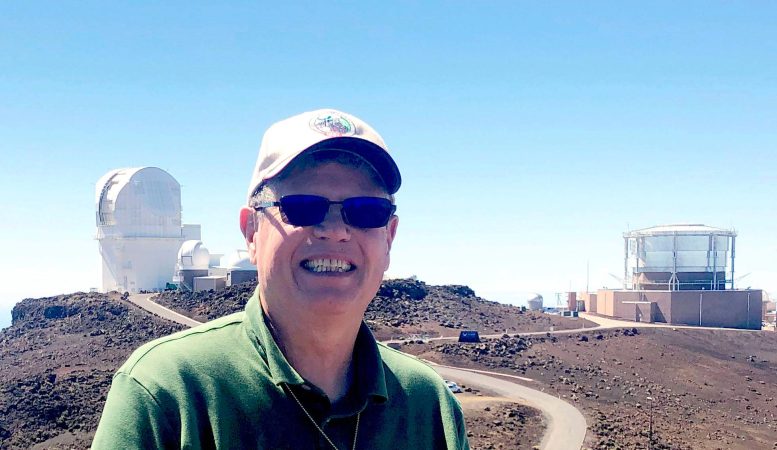This illustration depicts a Jupiter-like exoplanet called TOI-2180 b. It was discovered in data from NASA’s Transiting Exoplanet Survey Satellite. Credit: NASA/JPL-Caltech/R. Hurt
Tom Jacobs of Bellevue, Washington, loves treasure hunts. Since 2010, the former U.S. naval officer has participated in online volunteer projects that allow anyone who is interested — “citizen scientists” — to look through
Tom Jacobs, a citizen scientist who collaborates with professional scientists to look for exoplanets, at the Haleakalā High Altitude Observatory Site in Hawaii. Credit: Tom Jacobs
A graph showing starlight over time is called a “light curve.” The Visual Survey Group alerted two professional scientist collaborators — Paul Dalba at the University of California, Riverside, and Diana Dragomir, assistant professor at the University of New Mexico, that this light curve was potentially interesting.
“With this new discovery, we are also pushing the limits of the kinds of planets we can extract from TESS observations,” Dragomir said. “TESS was not specifically designed to find such long-orbit exoplanets, but our team, with the help of citizen scientists, are digging out these rare gems nonetheless.”
Computer algorithms used by professional astronomers are designed to search for planets by identifying multiple transit events from a single star. That’s why citizen scientists’ visual inspection is so useful when there is only one transit available. Since this is the only instance of the TOI-2180 b star dimming in this dataset, it is called a “single transit event.”
“The manual effort that they put in is really important and really impressive, because it’s actually hard to write code that can go through a million light curves and identify single transit events reliably,” Dalba said. “This is one area where humans are still beating code.”
But how could the team rule out other explanations for the brief dip in starlight? Could they be sure they had found a planet? They would need follow-up observations.
Fortunately, Dalba was able to recruit the Automated Planet Finder Telescope at Lick Observatory in California. “I use that telescope to measure the wobble of the star to then determine how massive this planet is, if it is a planet at all,” he said. The research team also used the Keck I telescope at the W. M. Keck Observatory in Hawaii to perform some of these measurements when Lick Observatory was threatened by wildfires.
With 27 hours of observations spread over more than 500 days, Dalba and colleagues observed the planet’s gravitational tug on the star, which allowed them to calculate the planet’s mass and estimate a range of possibilities for its orbit. Still, they wanted to observe the planet’s transit when it came back around to confirm the orbit. Unfortunately, finding a second transit event was going to be difficult because there was so much uncertainty about when the planet would cross the face of its star again.
Dalba pressed on, and organized an observing campaign including both professional astronomers and citizen scientists using telescopes at 14 sites across three continents in August 2020. To support the campaign, Dalba camped for five nights in California’s Joshua Tree National Park and looked for the transit with two portable amateur telescopes. The collaborative effort yielded 55 datasets over 11 days.
Ultimately, none of these telescopes detected the planet with confidence. Still, the lack of a clear detection in this time period put a boundary on how long the orbit could be, indicating a period of about 261 days. Using that estimate, they predict TESS will see the planet transit its star again in February 2022.
About the planet
TOI-2180 b is almost three times more massive than Jupiter but has the same diameter, meaning it is more dense than Jupiter. This made scientists wonder whether it formed in a different way than Jupiter.
Another clue about the planet’s formation could be what’s inside it. Through computer models they determined that the new planet may have as much as 105 Earth masses worth of elements heavier than hydrogen and helium. “That’s a lot,” says Dalba. “That’s more than what we suspect is inside Jupiter.”
Astronomers still have much to learn about the range of planets that are out there. About 4,800 exoplanets have been confirmed, but there are thought to be billions of planets in our galaxy. The new finding indicates that among giant planets, some have many more heavy elements than others.
In our solar system, gigantic Jupiter orbits the Sun every 12 years; for (function(d, s, id){
var js, fjs = d.getElementsByTagName(s)[0];
if (d.getElementById(id)) return;
js = d.createElement(s); js.id = id;
js.src = "https://connect.facebook.net/en_US/sdk.js#xfbml=1&version=v2.6";
fjs.parentNode.insertBefore(js, fjs);
}(document, 'script', 'facebook-jssdk'));
Read original article here
